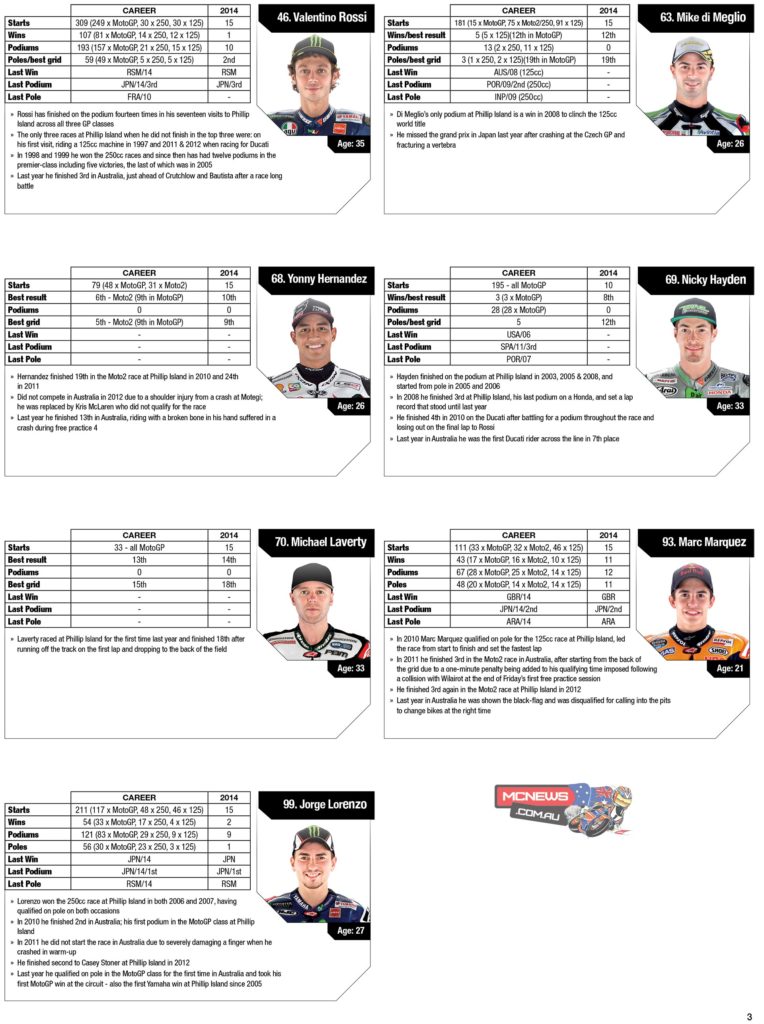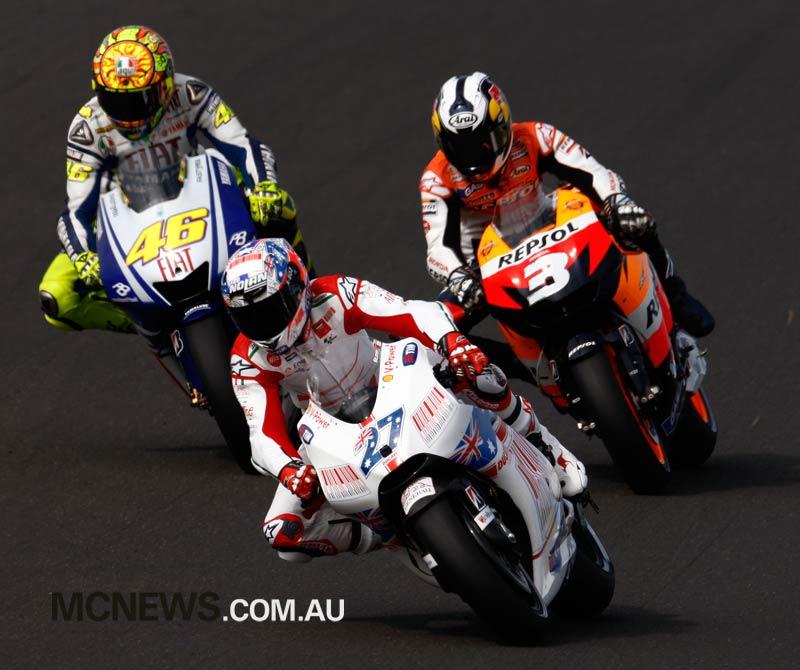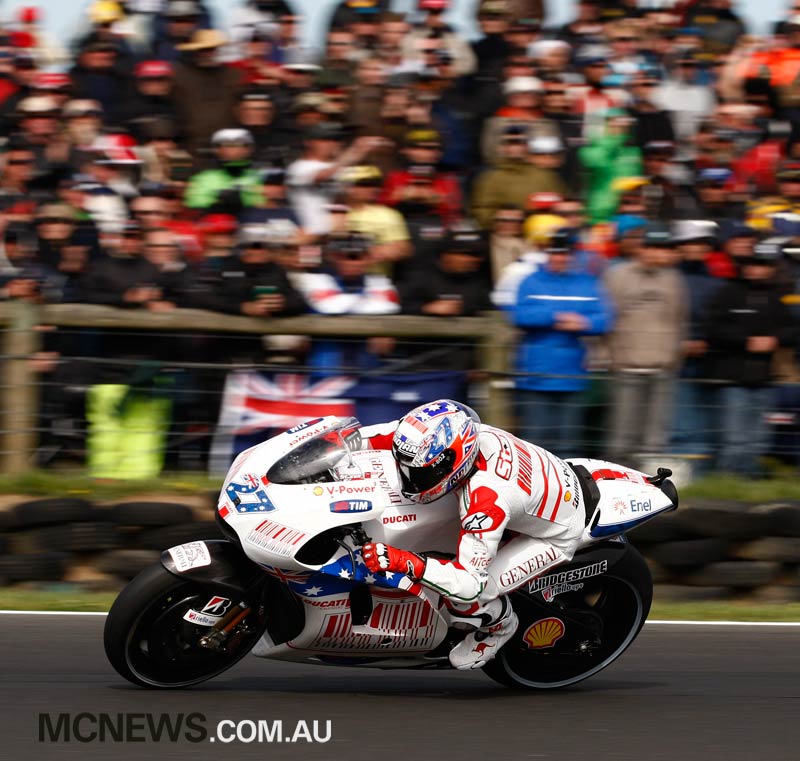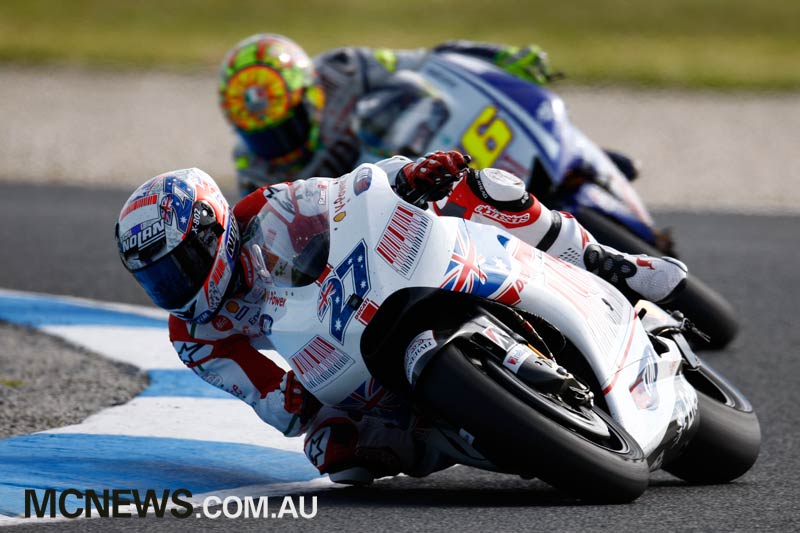MotoGP Phillip Island Statistics – Official statistics compiled by Dr. Martin Raines
Facts and stats from the Australian Grand Prix – This will be the 26th Australian Grand Prix, which has been held every year since the first visit in 1989. Below are some facts and statistics from the previous 25 Grand Prix events held in Australia:
- The first two Australian Grands Prix were held at Phillip Island, before visiting the Eastern Creek circuit for six successive years, then returning to Phillip Island in 1997 where it has since remained
- Honda is the most successful manufacturer at Phillip Island in the MotoGP era, with five victories. Ducati have had four MotoGP wins at Phillip Island and Yamaha three
- Valentino Rossi is the rider who has had most Grand Prix wins at Phillip Island, with seven (2 x 250cc, 1 x 500cc, 4 x MotoGP) followed by Casey Stoner with six wins, all of which have been in the MotoGP class
- Casey Stoner won the MotoGP race at Phillip Island for six successive years from 2007 until 2012, the last five of which were from pole position
- The only two current riders who have won in the MotoGP class at Phillip Island are Valentino Rossi and Jorge Lorenzo. Four current riders have started from pole in the MotoGP class at Phillip Island; Valentino Rossi in 2003, Nicky Hayden in both 2005 and 2006, Dani Pedrosa in 2007 and Jorge Lorenzo last year
- Casey Stoner’s victory at Phillip Island in 2010 remains the last time that a Ducati rider has stood on the top step of the podium
250 premier-class starts for Valentino Rossi – At the Australian Grand Prix, Valentino Rossi is scheduled to become the first rider to reach the milestone of 250 starts in the premier-class of Grand Prix racing. The following list shows the ten riders with most Grand Prix starts in the premier-class; this includes Nicky Hayden who at the Australian GP is scheduled to equal the number of premier-class starts of Colin Edwards, who is currently the highest placed American rider.
Rider Premier-class GP starts
- Valentino Rossi 249
- Alex Barros 245
- Loris Capirossi 217
- Colin Edwards 196
- Nicky Hayden 195
- Carlos Checa 194
- Kenny Roberts Jnr 167
- Sete Gibernau 160
- Jack Findlay 157
- Dani Pedrosa 148
Jorge Lorenzo levels with Mick Doohan – Jorge Lorenzo’s victory in Japan marked the 54th time he had stood on the top step of the podium in his Grand Prix career. This moves him into equal fifth place in the all-time winners list, with five-times 500cc World Champion Mick Doohan.
Riders with most Grand Prix victories (all solo classes)
- Giacomo Agostini 122
- Valentino Rossi 107
- Angel Nieto 90
- Mike Hailwood 76
- 5 = Mick Doohan 54
- 5 = Jorge Lorenzo 54
- 7 Phil Read 52
- 8 Dani Pedrosa 49
- 9 = Jim Redman 45
- 9 = Casey Stoner 45
Spain challenge Italy for most MotoGP wins – Jorge Lorenzo’s victory in Japan was the 85th win for Spanish riders in the MotoGP class since it was introduced as the premier-class of Grand Prix racing in 2002. This is just one less MotoGP win than Italy, as shown in the following table:
MotoGP wins by nation
- 1 Italy 86
- 2 Spain 85
- 3 Australia 40
- 4 USA 4
- 5 = Brazil 3
- 5 = Japan 3
800th GP in the intermediate-class – The Australian GP event will see the 800th race in the intermediate-class class (Moto2/250cc) of Grand Prix racing. When the World Championship was first introduced in 1949, the intermediate-class was limited to 250cc machines. Major changes to the rules were introduced for the 2010 season, with all engines being supplied by a single supplier and all of them 600cc four-cylinder four-stroke, with the class re-named Moto2. A selection of Grand Prix milestones in the intermediate-class are given below:
- June 1949 1 Great Britain – IOM TT – Irish rider Manliff Barrington (Moto Guzzi) wins the very first 250cc race counting towards the world championship. The race was run over a distance of 425 km in a time of 3 hours 23 minutes and 13.2 seconds. This was Barrington’s one and only GP victory.
- September 1949 4 Italy – Monza Bruno Ruffo (Moto Guzzi) finishes fourth at his home GP to become the first 250cc world champion.
- July 1952 17 Germany – Solitude Rudi Felgenheier (DKW) is the first rider to win a 250cc GP on a two-stroke machine.
- June 1953 21 Dutch TT – Assen Werner Haas gives NSU their first 250cc GP victory on his way to becoming the first rider to win the 125cc and 250cc titles in the same season.
- September 1955 38 Italy – Monza Bill Lomas finishes 5th to take the 250cc world title from Herman Paul Muller. However at the FIM congress in October it was decided to eliminate Bill Lomas from the Dutch TT results for refuelling without stopping his engine; consequently Muller inherits the championship and at the age of 45 is the oldest rider to win a world title.
- May 1961 70 Germany – Hockenheim Kunimitsu Takahashi becomes the first Japanese rider to win a GP; this is also Honda’s first 250cc GP victory.
- September 1961 78 Sweden – Kristianstad Mike Hailwood (Honda) wins the race to become the youngest ever world champion at that time and the first to win a world title on Japanese machinery.
- July 1963 94 Belgium – Spa-Francorchamps Fumio Ito gives Yamaha their first grand prix victory
- November 1963 99 Japan – Suzuka Jim Redman (Honda) wins the final race of the year at the first visit to Japan for a grand prix, to retain the 250cc world title.
- February 1964 100 USA – Daytona – On the first visit to America for a grand prix event Alan Shepherd (MZ) takes his only victory in the 250cc class, finishing more than a lap ahead of the second rider home.
- September 1964 109 Italy – Monza Phil Read wins in Italy to become the first rider to win a world title riding Yamaha machinery and the first to win the 250cc title riding a 2-stroke machine.
- August 1966 131 Finland – Imatra Mike Hailwood (Honda) takes a record ninth successive 250cc GP victory.
- September 1968 158 Italy – Monza – Phil Read wins the final race of the year to finish equal on points with team-mate Bill Ivy. Read wins the title on combined times in races both riders had completed.
- May 1969 159 Spain – Jarama On the first visit to Jarama for a grand prix event Santiago Herrero (Ossa) becomes the first Spanish rider to win a 250cc GP race.
- September 1969 170 Yugoslavia – Opatija Kel Carruthers (Benelli) wins the final race of the year to become the last rider to win the 250cc title riding a 4-stroke machine.
- June 1972 200 Yugoslavian – Opatija – Renzo Pasolini takes the victory riding an Aermacchi. This was one of three 250cc GP victories for the Aermacchi factory before the company was taken over by Harley Davidson and the bike re-branded for the 1973 season.
- March 1975 229 France – Paul Ricard Johnny Cecotto (Yamaha) wins on his grand prix debut at the age of 19 to become the youngest GP winner at that time.
- August 1976 248 Czech – Brno Walter Villa (Harley Davidson) wins at Brno to become the first rider to win three successive titles in the 250cc class.
- July 1977 258 Belgium – Spa-Francorchamps Walter Villa wins with the highest recorded average speed for an intermediate-class GP race, at 204.6 km/hr (127.1 mph)
- May 1981 300 French GP – Paul Ricard – Anton Mang (Kawasaki) wins on his way to retaining the world title. This was the first of nine consecutive 250cc victories, equalling the record previously set by Mike Hailwood.
- April 1983 322 France – Le Mans After qualifying in 31st place on the grid, 18-year old Alan Carter (Yamaha) becomes the youngest grand prix winner at that time.
- August 1985 353 Great Britain – Silverstone – After seven wins during the season, Freddie Spencer (Honda) finishes fourth at Silverstone to become the only rider to win the 500cc and 250cc titles in the same year.
- August 1987 378 San Marino – Misano Loris Reggiani gives Aprilia their first grand prix victory.
- April 1989 400 Spanish GP – Jerez – Luca Cadalora wins on a Yamaha. This was one of seven victories by Cadalora riding a Yamaha in the 250cc class before moving to Honda and becoming double world champion.
- September 1990 426 Australia – Phillip Island John Kocinski (Yamaha) wins the final race of the year to clinch the world title. This is the last race win in the 250cc class by an American rider.
- September 1993 468 FIM – Jarama Tetsuya Harada (Yamaha) wins the final race of the year to become the first Japanese rider to take the 250cc world title.
- October 1994 482 European – Catalunya Max Biaggi wins to clinch his first world title which is also the first 250cc title for an Aprilia rider.
- April 1996 497 Indonesia – Sentul Tetsuya Harada wins on his Michelin shod Yamaha and is the last rider to take an intermediate-class GP victory not using Dunlop tyres.
- May 1996 500 Italian GP – Mugello – Max Biaggi takes the victory in the 500th GP in the 250cc class riding an Aprilia on his way to winning his third consecutive world title on the Italian machine.
- April 1997 512 Japan – Suzuka 20-year old wild-card rider Daijiro Kato takes his first GP win in only his second grand prix start.
- October 1999 554 Rio – Jacarepagua Valentino Rossi clinches the world title, to become the youngest ever 250cc world champion at that time.
- October 2000 571 Australia – Phillip Island – In one of the closest championship battles of all-time Olivier Jacque passes team-mate Shinya Nakano on the run to the flag to win the title by just 0.014 seconds.
- November 2001 587 Rio – Jacarepagua World Champion Daijiro Kato wins a record 11th victory of the year.
- October 2002 600 Pacific GP – Motegi – Toni Elias riding an Aprilia takes his first GP victory in the 250ccc class at the age of 19, to become the youngest ever Spanish rider to win a 250cc GP at that time.
- April 2003 604 Japan – Suzuka Manuel Poggiali wins on his 250cc debut on his way to taking the world title.
- April 2004 620 South Africa – Welkom – Dani Pedrosa wins on his 250cc GP debut to become the youngest rider to win in the class on his way to becoming the youngest ever 250cc world champion.
- June 2005 641 Catalunya The first three riders across the line – Pedrosa, Stoner and Dovizioso are all under the age of 20. The first all-teenage podium in the 250cc class.
- March 2006 652 Spain – Jerez This is the first time since 1963 that a 250cc GP race has no Yamaha rider on the grid.
- June 2008 690 Italy – Mugello Marco Simoncelli gives Gilera their first 250cc GP victory.
- October 2008 700 Valencia – Ricardo Tormo Marco Simoncelli finishes his championship winning season in style with a victory at the last race of the year.
- November 2009 716 Valencia – Ricardo Tormo Hector Barbera wins the last ever 250cc grand prix race. Hiroshi Aoyama finishes seventh to become the last 250cc world champion.
- April 2010 717 Qatar – Losail Nineteen year old Shoya Tomizawa (Suter) wins the first ever Moto2 race.
- October 2010 730 Malaysia – Sepang Toni Elias (Moriwaki) finishes fourth at Sepang to become the first ever Moto2 world champion.
- May 2011 737 France – Le Mans Marc Marquez becomes the youngest ever winner of an intermediate-class GP race, at the age of 18 years 87 days.
- November 2012 767 Valencia – Ricardo Tormo Marc Marquez wins the final race of the year to set a new record point score in a single season in the intermediate-class of GP racing of 328 points.
- October 2014 799 Japan – Motegi Thomas Luthi takes the victory, after more than two years without a GP win.
Tito Rabat could take the Moto2 title in Australia – Following Tito Rabat’s third place finish in Japan, he now has a 38-point lead over his closest challenger Mika Kallio and could potentially win the title at the Australian GP. Rabat needs to increase his lead in the championship by at least 12 points to clinch the world title and the following scenarios would make Rabat World Champion this weekend:
- If Rabat wins the race and Kallio does not finish on the podium
- If Rabat is 2nd and Kallio finishes 8th or lower
- If Rabat is 3rd and Kallio finishes 12th or lower
- If Rabat is 4th and Kallio finishes 15th or lower
Grand Prix racing numbers
- 200 – At the Australian Grand Prix, Alvaro Bautista is scheduled to make his 200th Grand Prix start. Bautista made his GP debut as a wildcard in the 125cc class at the opening race of 2002 at Jerez. He then made wildcard starts at the other two events held in Spain in 2002 before becoming a full-time Grand Prix rider in 2003. He made 67 GP starts in the 125cc class and won the world title in 2006, before moving up to the 250cc class. After three years and 49 starts in the 250cc class, he made the move to the MotoGP class in 2010 in which he has made 83 starts to date. Bautista is the 25th rider to reach the milestone of 200 Grand Prix starts across all classes since the World Championship series was first introduced in 1949
- 121 – Jorge Lorenzo’s win in Japan was the 121st time he had stood on a GP podium across all classes: the same number of podium finishes that Phil Read achieved during his GP career. Only four riders have stood on the podium in Grand Prix racing more often than Lorenzo: Valentino Rossi (193 podium finishes), Giacomo Agostini (159), Angel Nieto (139) and Dani Pedrosa (134)
- 85 – Following the Japanese Grand Prix, Repsol Honda Team have an 85-point lead in the MotoGP Teams’ Championship; if they outscore their closest rival, Movistar Yamaha MotoGP, by five points they will take the Teams’ Championship in Australia
- 67 – The second place finish by Marc Marquez in Japan signalled the 67th time that he had stood on the podium in his GP career. This is just one less Grand Prix podium finish than Carlo Ubbiali, who won nine World Championship tiles in the 125cc and 250cc classes between the years 1951 and 1960
- 60 – Following the Japanese Grand Prix, Honda heads the Constructors’ Championship by 60 points from Yamaha. This means that Honda can clinch their 21st premier-class Constructors’ title in Australia by having one rider finishing on the podium, even if a rider from closest challenger Yamaha wins the race
- 50 – The Moto3 race in Australia will be the 50th in the class, which was introduced in 2012 to replace the 125cc category. The highly-competitive nature of the class is illustrated by the fact that there have already been 12 different winners in the Moto3 class and 20 different riders have stood on the podium
- 23 – Tom Luthi’s win in Japan was the 23rd time he had stood on the podium in the Moto2 class: the same number of podium finishes Pol Espargaro had during his time in Moto2. Only one rider has more podium appearances in the Moto2 class: Marc Marquez with 25
- 0.484 seconds – After another tremendous race-long battle at the Japanese GP, the first three riders across the line in the Moto3 race were covered by just 0.484 seconds. This was the tenth time in 2013 so far that the podium finishers in Moto3 had been covered by less than half a second
Moto2 stats and trivia
- Tito Rabat stills leads the championship heading to Australia, with a 38-point lead over his team-mate Mika Kallio. If Rabat increases his lead by 12 points or more at Phillip Island, he will leave the Australian Grand Prix as 2014 Moto2 World Champion
- Mika Kallio remains second overall as he looks to hunt down Rabat for a first ever world title; the Finn has never won at Phillip Island but has finished on the podium twice – second to Alvaro Bautista in the 2006 125cc race and third to Marco Simoncelli and Bautista in the 2008 250cc race
- Maverick Viñales is still placed third in the Moto2 World Championship standings and still holds a mathematical chance of clinching the title, as he is 70 points behind Tito Rabat with a maximum of 75 left on offer. Last year, he finished second in the Australian Moto3 Grand Prix, just three thousandths of a second behind Alex Rins in a dramatic photo finish
- Last year in Australia, the Moto2 race ran to a shorter distance than scheduled due to safety concerns involving tyres; Pol Espargaro won the race from Tom Luthi and Jordi Torres, while title contender Scott Redding was on the sidelines and out of action after fracturing his left wrist in a crash during Saturday’s qualifying session
- The Moto2 Australian Grand Prix has always been won from pole position: Alex de Angelis took a pair of back-to-back poles and wins in 2010 and 2011, while Pol Espargaro claimed the top spot in both qualifying and the race in 2012 and 2013
- Alex de Angelis and Pol Espargaro have each achieved the perfect score of pole position, race victory and fastest lap in the Moto2 Australian Grand Prix: the San Marino rider accomplished this in 2011, while the Spaniard took his turn in 2012
Moto3 stats and trivia
- Alex Marquez continues to lead the Moto3 World Championship heading to Phillip Island, having hit the front after the highly dramatic Aragon Grand Prix. His win at Motegi last weekend leaves the Spaniard with an increased cushion of 25 points, although this amount of points confirms that the title cannot be won in Australia this weekend
- Jack Miller is still second overall; the Queensland rider now heads into his home Grand Prix as a title contender, with his best World Championship result to date on home soil having been his fifth place on an FTR Honda last year
- Third overall in Alex Rins, who claimed victory in Australia 12 months ago. A costly Japanese Grand Prix leaves the Spaniard 37 points in arrears of teammate Marquez and in threat of being pushed out of the title fight at Phillip Island
- The 2013 Moto3 Australian Grand Prix saw a dramatic race decided by just three thousandths of a second, as winner Alex Rins and second-placed Maverick Viñales crossed the line in a photo finish; Luis Salom completed the podium from Alex Marquez and Jack Miller, with six tenths of a second covering the top five riders
- Sandro Cortese won the first Moto3 World Championship race to be staged in Australia, from pole position and en route to his title win in 2012
- In 2012, Miguel Oliveira finished second and Arthur Sissis third; this remains Oliveira’s only second place finish and Sissis’ sole podium finish to date
- Andrea Locatelli celebrates his 18th birthday on the Thursday before the race
- Zulfahmi Khairuddin will turn 23 on the Monday after the Australian GP






























